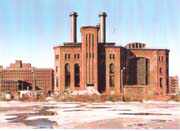The Port Authority can huff and puff, but it will not be able to blow the Powerhouse down.
After leading a two-year preservation campaign for the steel and brick structure, the Jersey City Landmark Conservancy declared a victory in early December when the National Register of Historic Places included the First Street edifice in its list of national landmarks, the 26th Jersey City structure to receive this status. As a result, the Port Authority is legally bound to preserve the building in its original form.
In turn, members of the Jersey City Landmarks Conservancy can rest assured that the structure will not be demolished, a fear that initially inspired the campaign.
“With all the major development going on, it’s important to keep remnants of the past,” said John Gomez, president of the Jersey City Landmarks Conservancy.
Standing in the middle of waterfront development on First Street, the Powerhouse once provided steam to run the entire subway system that connected New York to New Jersey. Built and operated by the Hudson & Manhattan Railroad system, the goliath structure served the entire network of commuting trains on both sides of the Hudson River from it the time it was erected in 1908 until it was closed in 1929. It became a storage house for railroad equipment thereafter, but was completely abandoned when the Port Authority Trans-Hudson Corporation (PATH) took over in 1962.
Currently, the ownership of the building is split between the Port Authority and Jersey City.
With a steel frame and an exterior that boasts ornamental bricks two feet wide, the Powerhouse was built to last forever. Similarly, its architectural beauty was immediately recognized when Teddy Roosevelt officially marked its opening. Designed by the same firm that built the esteemed New York Public Library in the heart of midtown Manhattan, the Powerhouse draws from a combination of architectural styles. Referred to as “Industrial Romaneseque,” the castle-like building mixes a classical framework with industrial-age features and a few Gothic touches.
But while the structure was intended to last more than a thousand years, a half-century of neglect has battered the interior beauty, rendering it a virtual ghost of an engineering palace. Aside from the mechanical infrastructure that made its name legitimate, the insides were adorned with porcelain tiles, marble steps, and copper fixtures.
If the Jersey City Landmarks Conservancy gets what it wants, the decrepit insides will be refurbished and landscaped for a new role in Jersey City.
Rumors of a plan to demolish the structure in 1999 inspired a group of Jersey City residents to form the Jersey City Landmarks Conservancy. Immediately, the 12-member organization sent in an application to the State Historic Preservation Office that would protect it from a destiny of rubble. Although it received approval from this 13-member board, the deal fell through when the request was rejected by the commissioner of the Department of Environmental Protection a year and a half later.
In the meantime, the Jersey City Landmarks Conservancy conducted an aggressive marketing campaign aimed at creating awareness of the Powerhouse and its history. The campaign gradually paid off as archeological newsletters, national preservation associations and the mainstream media began to pay tribute to the turn-of-the-century relic.
Even though the state had formally rejected the application, it sent it to the National Register of Historic Places out of protocol. It is rare that the national organization would accept something that was rejected on a state level, Gomez said. However, within two months he received the good news.
“The National Register listing for the Powerhouse is our biggest success,” Gomez said. “It’s lent some stature to us. We have a real credential now.”
For over a year, the Port Authority has been conducting a study on the best use for the property and the costs associated with those plans. Now that the building has been listed under the prestigious national registry of historic landmarks, there are certain restrictions as to what can be done to the landmark. “We objected to it on a state level because of some possible restrictions to using that building,” said Dan Bledsoe, a spokesman for the Port Authority.
In short, the Port Authority can not alter the structure.
Gomez said that is a relief, citing a former $62 million project to build an office building on top of the existing structure that the Port Authority was considering. “They wanted to have the option of altering the building in any way they saw fit,” Gomez said.
According to Bledsoe, there is no scheduled date for the study of the property to end. “Once the draft is complete, we’ll share that with the city,” Bledsoe said. “It will list three specific uses and the costs associated with those uses.” Bledsoe said he could not provide information about who was doing the study and how it was being conducted. Although Jersey City is a co-owner of the building, the Port Authority has conducted the study without involving city officials.
Bledsoe added, “We would not be limited to the options of the study.”
When the time comes, the Jersey City Landmarks Conservancy is eager to throw out its own suggestions. Gomez hopes the Powerhouse will serve as an art museum, history museum, or performing arts center. “We respect that it needs to make some kind of money for the owners, but we’d like to see some kind of cultural aspect come out of it.”
He added that he would not object to more commercial ventures, such as creating retail or residential space. Along that same vane, Leon Yost, a member of the preservation group, suggested the possibility of turning it into a convention center for Jersey City.
Either way, Gomez is convinced that the landmark status automatically makes it a lucrative entity for Jersey City. “The more tourists we get in here, the more they spend on local businesses,” he said. “Preservation is a money-making machine.”
